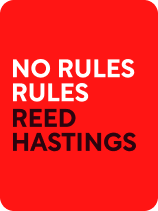

This article is an excerpt from the Shortform book guide to "No Rules Rules" by Reed Hastings. Shortform has the world's best summaries and analyses of books you should be reading.
Like this article? Sign up for a free trial here .
What is it like to work at Netflix? Does Netflix have an innovative culture?
As a company with no vacation or expense policy, Netflix is no stranger to taking an unorthodox approach to management. One of Netflix’s more unique policies is the freedom it gives to its employees to innovate and make risky decisions, despite the chance that they won’t pay off.
Keep reading to learn about Netflix’s method of inspiring innovation (what the company calls the “Netflix Innovation Cycle”).
Employees Bet on Ideas They Believe In
At Netflix, No Rules Rules co-author Meyer explains that employees are empowered to make risky decisions. This dispersed decision-making gives the employee the autonomy and power to take risks, as well as accountability when risks don’t pay off.
Company leaders expect some risks to fail, and they expect employees to learn from those failures to avoid making the same mistake twice. Employee performance is not based on the outcome of any single risk, but rather on their overall record of taking risks that benefit the company. That means that people don’t lose their jobs for taking a risk that doesn’t pay off—only for failing to take big risks or for taking consistently bad risks.
| Empowerment Only Works in Some Situations Netflix empowers its employees to make risky decisions, which has led to some big wins for the company. However, empowerment doesn’t work in every scenario. While delegating responsibilities to team members and asking for their input can improve job performance and satisfaction, the results vary depending on the task and circumstances. In particular, research shows that: Empowering employees encourages creativity, but it doesn’t improve the performance of routine tasks—in these cases, employees tend to view empowerment as an additional burden. Different cultures have different degrees of receptivity to empowering leadership. Eastern cultures tend to be more open to leaders who give additional responsibilities, while Western cultures, ironically, may view empowering leaders as controlling. Less experienced employees respond more positively to empowering leaders, possibly because they see additional tasks as a chance to prove themselves. By understanding the type of employees you have and the kind of work they do, you can figure out how much empowerment you should give them to produce positive outcomes. |
To help employees succeed, Meyer writes that Netflix has developed a four-step approach to proposing ideas (what the company calls the “Netflix Innovation Cycle”). Let’s examine each of the four steps in detail.
Step 1: Get Feedback
Although you don’t need approval to move forward on an idea, leadership expects you to make well-informed decisions, which includes gathering and considering feedback from managers and colleagues. Netflix CEO Reed Hastings writes that you’re likely to get a mix of support and dissent, all of which will give you insight as you alter, abandon, or move forward with your idea.
(Shortform note: The culture of openness at Netflix means that others get to weigh in on your ideas. While this kind of collaboration helpfully reveals potential problems and blind spots, it also has its pitfalls: Employees may be confused or uncomfortable with the lack of defined roles in a more fluid—rather than hierarchical—process, there may be in-fighting if employees don’t know how to express or accept dissenting opinions, and they may confuse collaborative discussions with action.)
Netflix’s culture of candor makes it an act of disloyalty to withhold disagreement or skepticism about an idea, because speaking up ignites discussion that could prevent someone from moving forward with a disastrous idea. Meyer notes that the feedback process is a critical first step in the idea-proposing process because it actively works against the human inclination to conform, which can lead people to go along with bad ideas.
(Shortform note: In workplaces that don’t have a culture of candor like Netflix’s, employees may hesitate to rock the boat with their feedback. In these cases, it’s important to create an environment that encourages employees to go against the consensus. In Originals, Adam Grant writes that you can prevent homogeneous thinking and surface dissenting ideas in three ways: First, ask onboarding employees for their opinions right off the bat. Second, look for authentic dissenters by asking employees to name coworkers who don’t speak up enough. Third, encourage people to speak up about problems even if they haven’t identified solutions.)
Step 2: Test Out Big Ideas
When a proposal involves a lot of time, work hours, and resources, it’s critical to test the idea on a smaller scale before committing to it full-out. (Shortform note: This is what Jim Collins calls “firing bullets before cannonballs.” First, companies launch “bullets,” or small-scale projects, to see which ones are viable. Then, they put all their firepower into “cannonballs,” or the projects that have the best chance of success based on the bullets. This method prevents companies from suffering catastrophic consequences from taking uncalculated risks.)
Most companies encourage some form of testing out ideas—but Meyer writes that Netflix urges employees to test ideas even if the bosses disagree with them. (Shortform note: Collins emphasizes that, as a manager, allowing small experiments that you may not agree with can be a game-changer and eventually lead to a major shift in business. In Built to Last, he writes that an unapproved experiment was how American Express went from being a freight company to a travel company.)
Step 3: Take the Lead
When you have a proposal, Hastings says you become the project manager (what he calls an “informed captain”), meaning you are responsible for researching, making decisions, and executing the project. The feedback and testing in Steps 1 and 2 are meant to make you a more knowledgeable project lead.
At many companies, you may spearhead a project, but you need signatures and approvals from higher-ups to move forward, and that takes some of the ownership out of your hands. At Netflix, as the project manager, you have decision-making freedom and ownership of the project from conception to execution. You negotiate the deals, you sign the contracts—and, Hastings emphasizes, you carry the burden of responsibility to do everything possible to ensure that your decisions help to move the company forward.
| Give Your Employees the Confidence to Take the Lead The tremendous amount of responsibility that comes with proposing an idea and following it through to completion might intimidate employees into inaction. Help them gain more confidence to propose projects and take risks by: –Making them aware of their lack of self-confidence and how it affects the team and their career progression –Building trust so that they know that you’re on their side Helping them identify and leverage their strengths as well as pinpoint and improve on their weaknesses –Giving them assignments with detailed instructions and well-defined deliverables before assigning more challenging projects that are still doable –Celebrating their accomplishments through praise or a congratulatory email, and giving them specific feedback about what led to their success |
Step 4: Share Failures and Celebrate Successes
If you’ve worked hard to seek feedback on, test out, and take the lead on your proposal, and it still fails, Hastings says that the only option is to learn from the experience. Share your failures by writing an open memo about your failed bet and what you learned from it. This sends the message that failure is part of the creative process and encourages others to innovate, while also giving everyone the opportunity to learn from the failure.
(Shortform note: As Hastings points out, failure is a normal part of innovation. It’s thus important for employees to learn how to deal with it, aside from owning up to it. In Dare to Lead, Brené Brown says you can help employees develop failure resilience, or the ability to recover quickly when something goes wrong. This entails first reassuring onboarding employees that they’ll be supported—not penalized—if they fail. Then, train them to respond to failure rationally rather than emotionally, separating facts from feelings to paint an accurate picture of the situation.)
Managers who disagreed with your proposal must be especially aware of how they react to its failure—if they smugly remind you of their dissent, they’ll smother innovation and make everyone risk-averse. Instead, managers should encourage employees to share about their failed bets, then focus on takeaways and move on.
(Shortform note: It’s important to learn to override your ego when you’re wrong to keep you from becoming defensive or combative. But it’s also important to learn to override your ego when you’re right and resist the urge to say, “I told you so.” Take a page from Bridgewater’s playbook and learn to value the best ideas, no matter where they come from, because the ultimate goal isn’t being right—it’s the company’s success.)
Alternatively, if your proposal is a success, you, your manager, and your team should celebrate it. If your manager initially disagreed with your idea, she should readily admit that she was wrong and that she’s glad you moved forward despite her reservations.
(Shortform note: Hastings writes that you should celebrate success, but he doesn’t say why it’s important to do so. Beyond being an emotional release, celebrating success encourages you to reflect on what led to success so you can determine how to replicate it.)

———End of Preview———
Like what you just read? Read the rest of the world's best book summary and analysis of Reed Hastings's "No Rules Rules" at Shortform .
Here's what you'll find in our full No Rules Rules summary :
- How Netflix achieved massive success in a short period of time
- The unusual business practices that have helped Netflix sustain its success
- Why Netflix fires adequate employees






